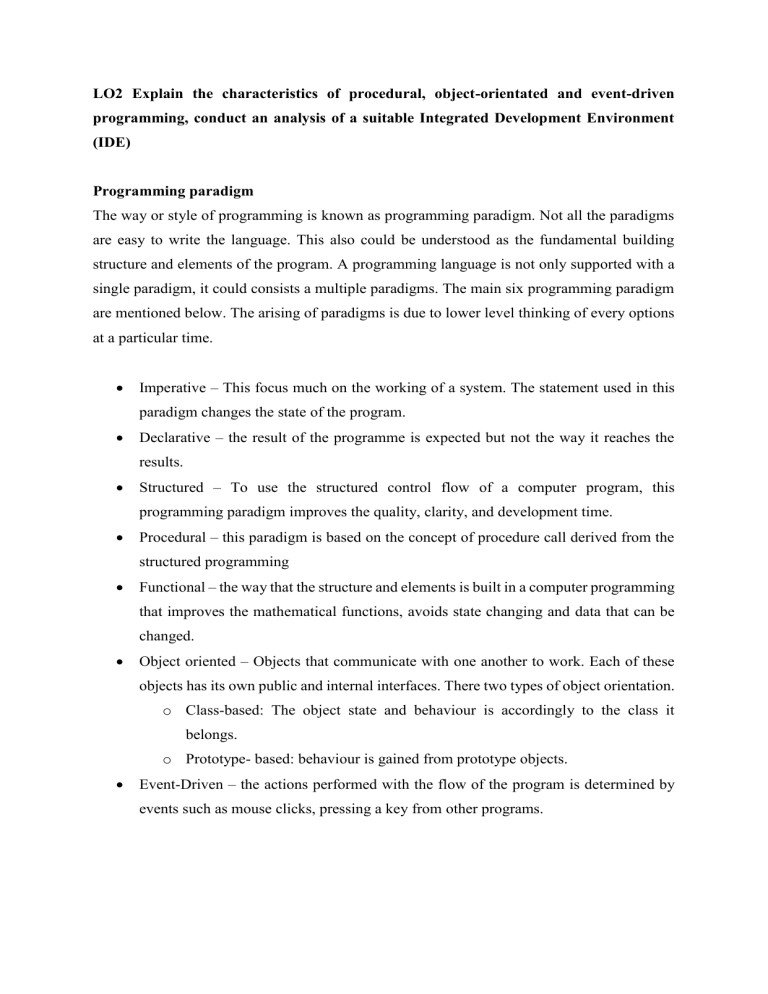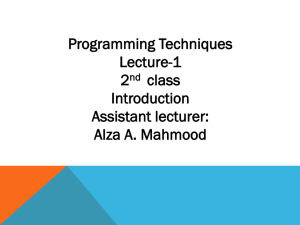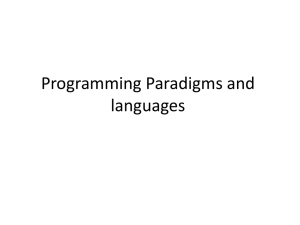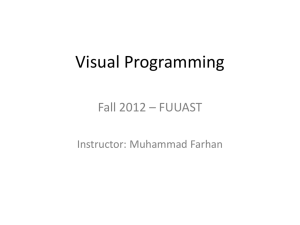
LO2 Explain the characteristics of procedural, object-orientated and event-driven programming, conduct an analysis of a suitable Integrated Development Environment (IDE) Programming paradigm The way or style of programming is known as programming paradigm. Not all the paradigms are easy to write the language. This also could be understood as the fundamental building structure and elements of the program. A programming language is not only supported with a single paradigm, it could consists a multiple paradigms. The main six programming paradigm are mentioned below. The arising of paradigms is due to lower level thinking of every options at a particular time. Imperative – This focus much on the working of a system. The statement used in this paradigm changes the state of the program. Declarative – the result of the programme is expected but not the way it reaches the results. Structured – To use the structured control flow of a computer program, this programming paradigm improves the quality, clarity, and development time. Procedural – this paradigm is based on the concept of procedure call derived from the structured programming Functional – the way that the structure and elements is built in a computer programming that improves the mathematical functions, avoids state changing and data that can be changed. Object oriented – Objects that communicate with one another to work. Each of these objects has its own public and internal interfaces. There two types of object orientation. o Class-based: The object state and behaviour is accordingly to the class it belongs. o Prototype- based: behaviour is gained from prototype objects. Event-Driven – the actions performed with the flow of the program is determined by events such as mouse clicks, pressing a key from other programs. Procedural Paradigm The performance of procedural programming is done step by step. The function is separated into smaller sections and then solved.The procedural code is the code that tells a device how to do a task in a logical order. This paradigm takes a top-down, linear approach to data and methods, and sees them as two different things. Procedural Programming separates a program into procedures, which are sometimes known as routines or functions and simply include a set of actions to be carried out, based on the concept of a procedure call. Simply put, procedural programming is writing down a list of instructions that teach the computer how to complete a task step by step. Some of the main features of procedural paradigm is mentioned below, Predefined functions A defined function is usually an instruction with a name attached to it. Predefined functions are usually included in higher-level programming languages, however they are taken from a library or registry rather than a program. ‘charAt()' is an example of a pre-defined function that looks for a character value in a string. Local Variable A local variable is a variable that is declared in the method's main structure and is only valid inside the scope of the method. The local variable can only be used in the method in which it is defined; if it is used outside of that function, the code will fail. Global Variable A global variable is one that is declared outside of every other function in the program. As a result, unique local variables, global variables can be used in any function. Modularity When 2 different systems are given two different tasks to complete, they are grouped together to complete a bigger task first. The tasks of each set of systems would next be completed one by one until all tasks were completed. Parameter Passing A system for passing parameters to functions, subroutines, and procedures is known as parameter passing. ‘Pass by value', ‘pass by reference', ‘pass by result', ‘pass by value-result', and ‘pass by the name' are all methods for passing parameters. Object oriented paradigm The primary idea behind OOP (Object Oriented Programming) is that messages are passed between objects. Methods are the responses provided by these objects when they conduct operations. These communications may contain arguments of their own. Objects in Python are organized into classes, with each class serving as a description for a group of related objects. A class instance is referred to as an object. The primary qualities of OOP are as follows: Encapsulation / Information hiding This is the concept of grouping data and operations within a class. This encapsulation is used to hide an object's internal state from the outside environment via way using. Methods only the data is available. The objects are made independent and allows to reuse objects in other applications. This makes maintenance easier. Figure 1 : Encapsulation Inheritance The classes can categorized into an order when some common features look among them. This allows to derive new classes from the existing classes. When a class is derived from another class the host class is known as the parent class or super class. New class formed from an existing class is called as a Sub class or child class. Child class or sub class get all the data and operations from a Super or parent class. In addition a sub class can contain its own data. A simple diagram is given below to understand inheritance further. Animal Vegetarian Deer Meat-eater Lion Omnivore Fox Human The inheritance can be categories into six types as follows Single inheritance A derived class can inherit properties and behavior from a single parent class using single inheritance. It allows a derived class to inherit the characteristics and behavior of a base class, allowing for code reuse as well as the addition of new features. Multi-level inheritance Is the concept of a single class extending (or saving) many base classes. Multiple inheritance A derived class takes a base class in multilevel inheritance, and the derived class also works as the base class for other classes. Multipath inheritance It's possible that a child will have two parent classes in a two-level inheritance. The two parent classes, on the other hand, could be developed from a single grandparent class. Hierarchical inheritance A type of inheritance in which more than one class is inherited from a single parent or base class is known as hierarchical inheritance. The base class shares many of the same properties as the parent class, especially those that are common in the parent class. Hybrid inheritance Simple, multiple, and hierarchical inheritance are all mixed in hybrid inheritance. A class is usually derived from two classes in multiple inheritances, with one of the parent classes being a derived class rather than a base class. Consider some of the advantages and disadvantages of inheritance. Code redundancy reduced Reusability of code Improves readability of code by reducing the source code size Code is managed easily by diving into parent and child classes Due to binding of parent class and child classes, any changes made to the parent class is affected to all child classes In a class hierarchy many data remains unused and memory is allocated is not utilized. Hence, program is affected if inheritance is not implemented correctly. Polymorphism Polymorphism refers to the ability to take on multiple forms. It can also be used to refer to the ability to modify methods for derived classes. When it comes to OOP, the ability to produce multiple (many) results with a single operation is important. Triangle Draw () Results Rectangle Shape Draw () Draw () Circle Draw () Figure 2 : Example of Polymorphism Event-Driven Event driven program is the reply given to the user events or similar input. The idea of event driven program is planned to react. In other words, event driven can be expressed, as the flow of program executed is determined through the events. Some characteristics of events driven paradigms Service oriented This is a programming paradigm that is used to write program that are specifically made for services. The request made by the user is satisfied. For example when the close button is press the application exits Time driven The code is setup to execute on a routine basis. This could be used to run a part of the code that is configured to run at a specified time. The update that appears when the system has a new release is an example of this. It asks the user whether or not they want to update by checking for updates on a time basis. Event handlers This function or method takes place when an event happens, when an event takes place they are performed I reply. For example, clicking a button one or many times the code is performed. Trigger functions The decision of code, which should be run when an event happens, is implemented by this trigger function. Events When the user relate with the object, for the events to take place it has to be triggered. Getting a click to a button by a mouse can trigger events in many ways. The events occur due to the code being assigned for a button. Not only mouse even keyboards can be used to set create events. Relationships of the Procedural, Object-oriented and event driven programming “Procedural programming means that you define a program and its subprograms as a series of steps. In contrast, declarative programs try to describe the result without regard to the steps taken to computer it but rather some description or denotation of the desired result. Object oriented programming is a way of organizing code around the principles of encapsulation, inheritance, substitution, programming to interfaces, and so on. Object oriented programs are usually mostly procedural. Event based programming is about writing event handling procedures and having the core event loop provided by the underlying system. In this way, you can save the trouble of writing your own event loop and benefit from various libraries that already work with the system provided event loop. Event based programs are very often writing using object oriented style, but not always. These three categories are thus not related strictly hierarchically, but in common usage they are mostly nested within one another.” (Vandermeer, 2020) Example Code for the Programming paradigms (Code and Output) Procedural Paradigm Figure 3 : Procedural Paradigm Code Figure 4 : Procedural Paradigm Output The procedural paradigm example is given above. H is the height, W is the Width if we need to get an area we need to multiple the Vales The output is according done one by one in the Values mentioned in the figure 5. Object oriented program Objects of are basic building blocks of OOP in C#.A combination of data and method is known to be an object. Data and methods are the members of an object. The objects created in OOP program are connected together via methods. Every object can send messages, receive messages and process data. In creating an object there two this s to consider. First, a class is defined. An objects template is a class. It is a blueprint, which particularly describes the performance and state that objects of the class shared by all. Many objects can be created using a class. Objects that are created at the runtime of a class are recognized as examples of that relevant class. Figure 5 :OOP example In the above example, simple object is created. This show is a simple class where the body of the template is empty. There are no any data or methods. A new instance of subject class is created. A keyword new and a variable su is used to handle the object created. The object is printed to comfort to get some basic data of the object. Considering the reason to use print option to an object. When an object is printed it is called to its Tostring () method. But theatre are no any methods yet defined. When the objects are created su is inherited from base object. Some elementary functions are share among all created objects. The object class name returned as a result. Event-Driven paradigm Event-driven programming is a programming paradigm in which events, such as a user action such as a mouse click or key press, or a message from the operating system or another program, determine the flow of program execution. An event-driven application is one that activates events as they happen and responds with an appropriate event-handling technique. The concept is based on interrupt-driven programming, which was popular in early command-line environments like DOS and embedded computers. the following mentioned diagram is an example for event driven paradigm. The developer creates a login form for the system and the login buttons code is stated. When the button “Login” is clicked after entering the correct Username and Password the next Main form of the system appears. The process done when a click is made to the button called as event driven paradigm. In other words, the system responds when the “login” button is clicked. Figure 6 : Login From Figure 7 : Login Button Code Differences and the Unique Characteristics of Procedural Programming, Object Oriented Programming and Event-Driven Programming Procedural Programming Object Oriented Programming Event-Driven Programming Provide character user interface to write the commands. Provide command writing in modules. Provide graphical user interface to create the program. Low data security. High data security. It’s tightly connected to the declarative programming. Writing code is relatively simple. Writing code is harder. Basic elements are variables and functions. Hierarchical structured program. Graph structured program. Widely used in graphical user interface. Less flexibility. More flexibility. More flexibility.



